Interdisciplinary Learning & Program Integration
INTEGRATED LEARNING
In the Spring of 2015, the leadership of YouthBuild Charter School of California (YCSC) engaged in conversations with community-based partners about more closely aligning our school activities to community engagement. Such an alignment was already a stated goal of our school. And, our curricular model promotes authentic project-based learning and community action projects. In fact, each of our 19 campuses is housed on the premises of a community-based nonprofit leadership program. Even so, the daily activities of our school did not allow for the integration and participation in activities that would enhance learning and leadership development for our students.
In integrated learning, students are working in collaboration with community organizations to study social and political issues and to enact change. Right now, the class is the setting for reflection about the world. In this new model, the world is the setting for engagement with people and ideas. Such a model draws on learning theories of sociocultural learning and on models of community organizing.
After discussing with our community partners what a new school and curricular model might look like, the YCSC founder and CEO, Phil Matero, gathered further ideas from charter school staff members. He presented this new vision to the school community at the spring professional development. At that event, another Assistant Principal, Emily Bautista, and I led a workshop on integrated learning.


We sketched out how this new school and curricular model aligned with our current vision and practice. We also discussed practices and structures to consider in making this model work. Next, we asked the approximately 40 staff members in audience to help us think plan next steps in outlining and implementing this vision for the 2015-16 school year.
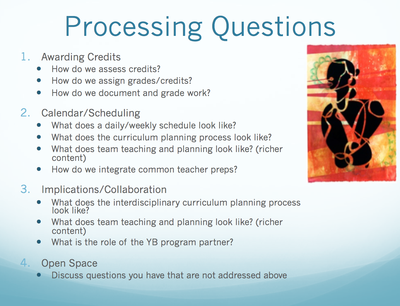
At the end of the workshop, Emily and I invited attendees and our community partners to meet weekly at the offices of YCSC to further develop the interdisciplinary learning and program integration (ILPI) model.
Before the initial meeting of the newly formed ILPI Committee, I met with a UCLA professor, Merle Price. Professor Price worked as an assistant principal and a principal at schools that implemented the Humanitas model. This curricular model was the original inspiration for YCSC's authentic learning model. And, Humanitas continues to provide inspiration in its interdisciplinary and thematic approach to learning. Professor Price provided information, contacts, and context that have proven useful in ILPI Committee meetings.
INGLEWOOD PILOT
Immediately after the spring professional development, 2 of our school campuses were interested in piloting an integrated approach to learning during the 3rd trimester, from April through June 2015. Emily and I met with the education teams and nonprofit partners from Inglewood and Lincoln Heights. In Inglewood, YCSC partners with the Youth Justice Coalition (YJC); in Lincoln Heights, we partner with Leadership through Empowerment, Action & Dialogue (LEAD).
During this initial planning meeting, the Lincoln Heights teachers hesitated to fully adopt the model. Instead, they wanted to experiment with co-teaching some courses. The Inglewood team, on the other hand, fully accepted the challenge of recreating their school schedule in the 3 days before the start of the new trimester. During those planning days, the teachers, representatives from the YJC, and I thought about how to revolved the curriculum around the YJC campaigns: War on Youth, Conditions of Confinement, School to Jail Track, Police Accountability, Know Your Rights, and LA for Youth. These campaigns would provide rich and authentic learning contexts for our students.
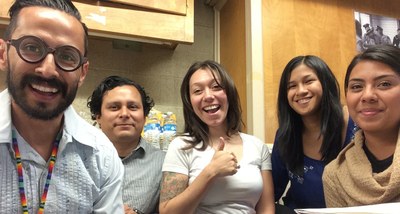
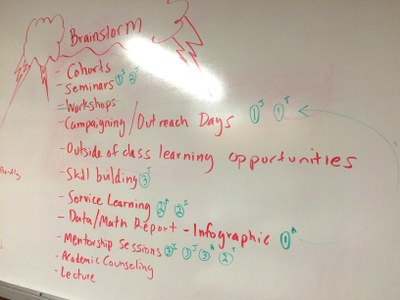
After many meetings, the Inglewood staff and I sketched out a trimester and a weekly schedule. This schedule would provide youth with the academic rigor and skill development necessary to be intellectuals and activists as they engaged in the YJC campaigns. Throughout the trimester, I visited the Inglewood campus, at minimum, on a weekly basis to join staff meetings, observe teachers, and discuss progress and challenges in implementing the model.
IL COMMITTEE MEETINGS
Emily Bautista and I co-facilitated the initial ILPI Committee meetings. During the first meeting, YCSC teachers and community partners defined what integration looked liked for them. We also reviewed the YouthBuild mission statement. During the following meetings, the participants looked at our current curricular model and read about the Humanitas model. We discussed issues that would have to be figured out, such as resources, planning time, the student information capacity, training for counselors, and community partner responsibilities.
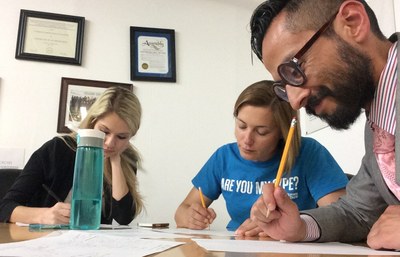
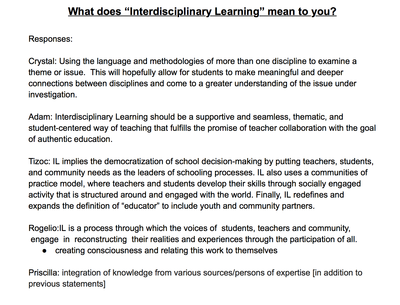
After the initial meetings, the ILPI Committee started holdings its sessions on Tuesdays, which conflicted with my classes at UCLA. As such, after that, I read the notes afterwards and volunteered for tasks between meetings. One of my first tasks was to help develop a survey for YCSC staff members and community partners. Each one of our school campuses is unique in terms of staffing, programs available from the partner, and even physical space. Ultimately, however, this survey was abandoned, because of the overwhelming number of questions.
The IL Committee eventually decided that our current curricular model, outlined in the Authentic and Collaborative Education Manual, contained all of the elements of an integrated model. The need was, then, to revise these forms, provide more targeted training to staff members, and encourage integration. The committee then began the process of revising the curricular manual. The manual includes sections on collaborating with YCSC staff members, collaborating with community partners, writing an essential question, planning a community action project, and developing curricular materials.
Emily Bautista and I volunteered to rewrite the sections on planning a community action project. She and I had been conversing for a year about revising the community action model to look more like participatory action. In fact, my leadership fieldwork project was inspired by those conversations. She and I discussed three primary areas for improvement: 1) integrating social investigation as the first step before taking action, 2) defining community action projects in terms of participatory action, and 3) providing a graphic to demonstrate different forms of community organizing along a range from service to advocacy.


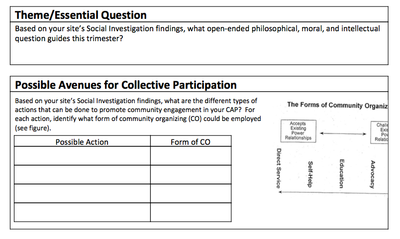
LEADERSHIP
Through this fieldwork project, I developed my skills according to several California Administrator Performance Expectations (CAPEs).
- CAPE 1: Developing and articulating a vision of teaching and learning for the school.
- CAPE 2: Developing a shared commitment to the vision among all members of the school community.
- CAPE 4: Sharing leadership with others in the school community to help accomplish the vision.
- CAPE 5: Promoting implementation of K-12 standards, pedagogical skills, effective instructional practices and student assessment for content instruction.
- CAPE 6: Evaluating, analyzing, and providing feedback on the effectiveness of classroom instruction to promote student learning and teacher professional growth.
- CAPE 10: Implementing change strategies based on current, relevant theories and best practices in school improvement.
- CAPE 16: Understanding and managing the complex interaction of all the school's systems to promote teaching and learning.
- CAPE 20: Involving the community in helping achieve the school's vision and goals.
NEXT STEPS
The ILPI Committee plans to hold 3 meetings during the summer. The meetings will have two goals: completing the new curricular model and planning the summer professional development, which begins on July 29th. Several other issues are yet to be resolved: training for counselors, student information system capacity, adapting the model to sites with different resources, and a daily and weekly schedule.

